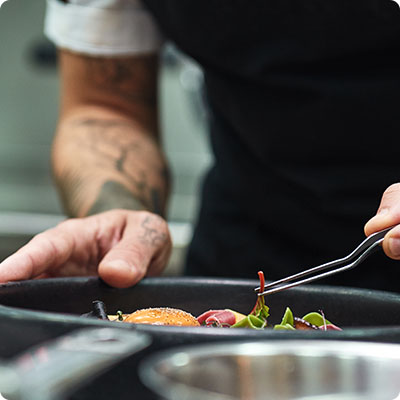Characteristic products
Vegetables are widely used in the local cuisine: carrots, cabbage, tomatoes, squash, cucumbers, peppers, eggplant, zucchini, not forgetting kidney beans, which can exceed 90 cm in length, or bitter melon, also known as margosa. Leafy vegetables (spinach, cassava leaves or squash) are sautéed with oil, garlic and chili pepper. Coconut is essential to the local cuisine, and its flesh is used as well as its water, milk and oil. Peanuts are also widely used, and are an ingredient in many dishes, as is the bancoulier nut or kemiri, which is ground to thicken sauces.
There's a particularly wide choice of spices: star anise, tamarind, ginger, turmeric, cinnamon, pepper, cloves, nutmeg, lemongrass, kaffir lime leaves or combava, and chillies of all kinds, including the fierce bird's eye chilli. Garlic, shallots and onions are used almost systematically in most dishes, and are often added fried as a garnish. Pandan leaves, a type of palm, are prized for their delicate coconut and vanilla flavor.
Other condiments such as fermented shrimp paste(belacan in Malay / terasi in Indonesian), with its powerful aroma, are used to season foods. While soy sauce originated in China, kecap manis - a syrupy soy sauce thickened with molasses - comes from Indonesia, as does sambal. Ulek sambal (chili puree, garlic, vinegar and salt) is the most basic version, but this condiment comes in many forms: sambal belacan/terasi (with shrimp paste), sambal jeruk (with kaffir lime leaves), sambal mangga muda (with pieces of green mango), sambal tempoyak (with fermented durian paste) or sambal kicap (with soy sauce and fresh onion).
Stretching between the Andaman Sea and the Pacific Ocean, the Malay Peninsula and Borneo put fish and seafood on the menu in a variety of recipes. These include bonito, tuna, mackerel, pomfret, king mackerel, grouper, jack mackerel, red snapper, anchovy, swordfish, shark and skate, not to mention a host of seafood such as squid, cuttlefish, prawns, crabs (including the prized blue crab) and various shellfish. Seafood and fish can be grilled, fried or cooked in sauce, but can also be dried and salted. Tilapia, carp and catfish are popular freshwater fish.
Chicken is the most popular meat. Indeed, in the three predominantly Muslim countries of Malaysia, Indonesia and Brunei, pork is rarer, though much sought-after by Christians and Hindus, who traditionally eat little or no beef. Goat, lamb, mutton, duck and some game are also popular. Vegetarian alternatives include tofu and tempeh, a type of fermented soybean bread. As in the rest of Southeast Asia, rice is obviously a major ingredient and a side dish eaten morning, noon and night. Locals are also very fond of noodles and vermicelli, whether made from wheat, rice, soy or tapioca.
When it comes to eating out, you'll find everything from a small grill or noodle stand to a Michelin-starred international restaurant. Local restaurants on the outskirts of markets, called " warung " on the Indonesian side, with a few plastic tables and benches bordered by hanging canvases, are incomparable places to enjoy excellent local dishes, all at low prices. With a sizeable Chinese and Indian community, there are of course many restaurants serving Chinese and South Asian cuisine. In Kuala Lumpur, where a large number of expatriates work in international business, restaurants offer a gastronomic range similar to that of all major capitals, from American fast-food out lets to upmarket French or Japanese restaurants.
Borneo specialities
The island of Borneo is divided between the two Malay states of Sabah and Sarawak, the Indonesian territory of Kalimantan, and Brunei, all of which have their own specialties. In the northeast, in Sabah, there are many dishes from the Kadazan-Dusun, the region's majority ethnic group. These include the very popular amplang, a type of fried cracker made from mackerel and tapioca starch. On the seaside, there's pinasakan, a fish dish simmered with takob-akob (dried skin of the eponymous fruit, prized for its acidity) or slices of bambangan, a fruit endemic to Borneo, also prized for its tangy taste. Sagol or sinagol consists of cooked and chopped fish, sautéed with turmeric, garlic, ginger, onion and lemongrass. Typical of the Kadazan-Dusun people,hinava is made with raw fish - often mackerel - mixed with lime juice, bird pepper, shallots and grated ginger.Hinava gipan is a variant with shrimp.Ensaladang lato is made with latok or "sea grapes", a seaweed that forms clusters of crunchy, iodized pearls, which are garnished with tomato, green mango, onion and vinegar. The astonishing bosou or noonsom will be reserved for the more adventurous. This is a preparation based on rice and fish, sometimes meat, fermented with salt and pangi nut or buah keluak, used as a preservative.
Piaren ah manuk is a chicken curry made with milk and grated coconut. A variant is prepared with green jackfruit(piaren ah badak). Zinalau bakas is a type of grilled meat prepared with wild boar or pork, braised for a long time on a grill and served with rice and various sauces. Fried pork or zhà ròu is a specialty of Sandakan, where there is a large Chinese community. Marinated pork is fried then sliced, usually served with soup and large vermicelli. Another Sandakan recipe, pí dàn jǐao is a variety of steamed ravioli filled with minced pork and a slice of hundred-year-old egg. This Chinese specialty is made with duck eggs that ferment in a mixture of lime, rice bran, salt and ash, making them brown and translucent with a strong sulphurous odour.
Noodles, as in the rest of Malaysia, are common. Among the classics are Beaufort mee - named after the town of the same name - wheat noodles with smoked pork or seafood and Chinese cabbage, topped with a thick sauce. Tuaran mee are fried noodles with omelette, vegetables and meat or seafood. Originally from Tawau, saang nyuk mian is served in two parts: on one side are noodles sautéed in a mixture of dark soy sauce and pork fat, and on the other are noodles in a rich aromatic broth with meat and pork dumplings, garnished with fresh herbs. Another soup, ngiu chap, is made with beef broth, topped with noodles, sliced beef, meatballs and various offal.
Rice is processed in a variety of ways. Examples include linongot, a steamed papillote of rice and root vegetables (sweet potatoes and/or yams), served with fish and various garnishes, or nasi kombos, glutinous rice cooked with coconut water and then mixed with freshly grated coconut meat. Finally, nuba laya is steamed rice paste. A common flavoring, tuhau is a type of wild ginger, chopped with lime juice, spring onion, chillies, salt and vinegar.
In the state of Sarawak, street stalls sell tasty kompia, rolls filled with minced meat and onion. Of Chinese origin, Kuching siew pau are flaky turnovers stuffed with meat, while sio bee are a local version of siu mai, a kind of steamed morsel stuffed with pork. Manok pansoh is a typical preparation of the Iban people, consisting of chicken seasoned with lemongrass, ginger and tapioca leaves, then stuffed into a bamboo tube and roasted over embers. Closely related,asam siok also contains rice.Umai is a traditional dish of the Melanau people, generally eaten by fishermen. It consists of raw fish with a mixture of onions, chillies, vinegar, salt and lime juice.
Noodles are also very popular in this state. Sarawak's famous laksa noodles are a popular choice, but other recipes include kolo mee, an egg noodle mixed with a sweet shallot, lard and vinegar sauce, topped with marinated minced pork and char siu (barbecued Chinese glazed pork). Tomato mee is a dish of fried noodles in tomato sauce, topped with seafood. Belacan bihun is a recipe for rice vermicelli topped with a sauce made from chillies, shrimp paste(belacan), tamarind and dried shrimp, before being garnished with cuttlefish, cucumber, bean sprouts and hundred-year-old egg quarters. Finally, mee sapi contains noodles in a beef broth, garnished with bean sprouts and beef slices.
The rice is eaten in the form of nasi aruk Sarawak, a stir-fried rice with garlic, onion and anchovies, similar to the very popular Indonesian nasi goreng, but much less oily. Nasi goreng dabai is rice sautéed with dabai, an indigenous fruit found only in Borneo, whose taste varies between almond and olive. Nasi lelapan is a rice dish served with various fillings (fried fish, chicken and/or beef, fresh vegetables, fried tofu, fried egg, chili paste). Finally, bubur pedas is a type of congee, a rice soup richly flavored with turmeric, lemongrass, galanga, chili, ginger, coconut and shallots. Peanuts and dried fish are sometimes used as garnishes.
There are many vegetable dishes, such as sayur manis, a leafy vegetable sautéed with chillies, shallots, garlic, oyster sauce and pieces of omelette. The famous Sarawak acar timun is a recipe for pickled cucumber prepared with sugar and vinegar. It is often served with keropok ikan, a kind of fish cracker. Midin consists of young wild fern shoots, sautéed with garlic and dried shrimp. There are also soups, such as sup terung dayak made with yellow eggplant (or terung asam), fish and shrimp, or sup paku kubok, a fern soup cooked withikan bilis (anchovy) and ginger.
In the Kalimantan region, you'll find many banjar specialties, such as soto banjar (a light soup with chicken, vermicelli, fish croquettes and hard-boiled egg), mie bancir (fried noodles with chicken and hard-boiled cane egg) or ketupat kandangan (steamed rice balls with coconut milk and grilled fish). Other Indonesian classics include nasi goreng (fried rice with chicken, seafood and fried egg), rendang (beef stew in a thick, spicy coconut milk sauce), nasi padang (white rice with curry sauce, fried chicken, fish, sautéed vegetables and minced beef) or gado-gado (cooked and raw vegetable salad with hard-boiled egg and peanut sauce).
While Brunei's cuisine is broadly similar to that of the rest of Borneo, the country's national dish isambuyat, a kind of sago starch jelly (a local palm) served with grilled fish, chilli sauce and a variety of raw vegetables.
Malaysian cuisine in Kuala Lumpur
In Southeast Asia, meals are not necessarily as clearly divided as in Europe, and dishes are generally served at the same time. Snacks and appetizers include the very popular rempeyek, a kind of cracker with peanuts and anchovies. Otherwise, it's impossible to miss popia basah, crispy spring rolls filled with turnips, grated carrots, fried onions and bean sprouts. Although the origin of satay is probably Indonesian, these finely spiced beef or chicken kebabs are a must when visiting Malaysia. They are usually served with a creamy peanut sauce.Otak-otak is a spicy fish paste grilled in a banana leaf, giving it the appearance of an elongated croquette when cooked. Finally, rojak ("mix" in Malay) is a sweet-and-sour salad of fruit, vegetables and fried dough cubes, sprinkled with peanuts. There are several flatbreads called " roti ", such as the roti canai, reminiscent of an Indian naan, generally used for dipping in curry. Or the pretty roti jala ("bread-in-filet" in Malay), which resembles a delicate lace of dough.
Rice is absolutely essential to the Malay diet. Although it is often served as a side dish, it is also prepared in more elaborate ways. Nasi lemak - rice cooked by evaporation in coconut milk - is the national dish. Then there's the surprising nasi kerabu, whose blue color is due to the flowers of telang, or Clitoria ternatea. It is garnished with bean sprouts, fried shallots and often an assortment of meats. Rice is sometimes cooked in rather unusual ways, as with lemang, stewed with coconut milk in a bamboo; or as with ketupat, where the rice is simmered in a kind of cooking bag woven from palm leaves.
There are also many noodle dishes, originally from China, such as mee goreng, a dish of fried wheat noodles with shrimp, chicken, omelette, shallot, soy sauce and peanuts. Mee rebus is quite similar in terms of filling, except that the noodles are bathed in a rich, curry-like soup. Finally, laksa is one of the hallmarks of Malay cuisine. This creamy soup made with coconut milk, lemongrass, tamarind and chili is garnished with noodles, fried tofu, bean sprouts, shrimp - or chicken - and coriander. Laksa from Borneo's Sarawak province is said to be the best in Malaysia.
While pork is moderately consumed in this Muslim-majority country, although it is much appreciated by the Chinese community, other meats such as chicken and beef are also very popular.Ayam percik is a recipe for chicken marinated in a rich coconut milk seasoning, then barbecued. The very popular ayam goreng is Malay for "fried chicken". A simple but delicious recipe, it's found all over the country. Gulai ayam kampung is a deliciously creamy chicken and potato curry, flavored with turmeric, kaffir lime leaf, lemongrass and a little palm sugar for sweetness.
Stretching between the Strait of Malacca and the South China Sea, the Malay Peninsula is no slouch when it comes to seafood.Asam pedas is a fish and vegetable curry, whileikan bakar is a whole fish marinated in a chilli sauce and barbecued. Sambal udang is a shrimp dish in a chili sauce with tamarind and shrimp paste. A similar variant is sambal tumis sotong, based on squid.
Sweets and tea time
The concept of dessert at the end of a meal is not necessarily self-evident in Southeast Asia. Sweets can be enjoyed all day long, but not necessarily after a savoury meal, at the end of lunch or dinner. Among the most common pastries are kuih, found in both Malaysia and Indonesia. This generic term refers to a large number of small rice-flour cakes, somewhere between muffins and flans. Often adorned with intense colors - artificial or natural - these cakes are generally flavored with coconut milk, vanilla, spices and more. But the term is vast and sometimes also includes doughnuts or even filled pancakes.
This is the case, for example, ofapam balik, a kind of huge pancake - often bought from street stalls - topped with sweet corn cream and crushed peanuts. The kaya toast is a kind of sweet sandwich, filled with coconut jam and beaten egg, which is toasted before serving with a cup of tea. Another symbol of local street food is the goreng pisang, a succulent banana fritter found everywhere. Pandan chiffon cake is an airy sponge cake flavored with pandan leaf. Typical of Sandakan, the UFO tart is a tartlet filled with toasted meringue and custard, while bee pang are crispy rice cakes popular in Sarawak. And don't forget gula mitai, a kind of cotton candy from the same state.
Sago starch, similar to tapioca, is used to make sago gula melaka, a pudding generally topped with palm sugar syrup just before serving. There are also many cold desserts in the form of sweet soups, such as the coconut milk-based bubur cha-cha, garnished with fruit cubes and tapioca balls. In a similar vein,ais kachang is a crushed ice dessert, molded into small domes and topped with syrups, condensed milk and red bean cream.
Discovering the Malay Peninsula and Borneo is an opportunity to feast on mangoes, pineapples and sweet papayas. Not forgetting other more unusual varieties such as the rambutan, a hairy cousin of the lychee, the mangosteen, which reveals its delicate sweet white pulp beneath its thick purplish skin, or the longan, with its brown rind revealing translucent flesh. The bravest will try the durian. Covered in spikes like a medieval club, its creamy yellow flesh sows doubt among gourmets: some say it's one of the most delicate fruits there is, while others compare its taste to a cross between macerated onions and an overdone Camembert. Its smell even makes it a forbidden fruit in most hotels and on airplanes. All you have to do is taste it to make up your mind.
While it was the Chinese who introduced the Malays and Indonesians to tea, the English were the first to cultivate the plant in the Malay Peninsula in the late 19th century, and later in Borneo. Indeed, the climate of certain mountainous regions - around the Cameron Highlands and the Crocker Mountains at altitudes of between 1,000 and 1,500 m - is a perfect copy of the temperatures in southern China, where tea originated. Malaysia and Indonesia mainly produce black tea, which goes into teh tarik, an extremely popular hot or cold drink with tea and sweetened, whipped, frothy condensed milk. Pak kopi, a coffee with sweetened condensed milk, is also popular, although tea remains the country's most popular hot beverage. Other beverages include freshly extractedair tebu , or sugarcane juice, and a wide variety of fruit juices.
In these three largely Muslim countries, locals are all the more fond of fruit juices and other fizzy drinks, as access to and consumption of alcoholic beverages are highly regulated. On the Indonesian side, the policy remains relatively flexible for all communities, while in Malaysia Muslims are technically not allowed to consume them. However, there is some flexibility in Borneo, particularly in the predominantly Christian state of Sarawak. On the other hand, the sale of alcohol is totally forbidden in Brunei, but tourists are allowed to consume it if they bring it from their country of origin. In Malaysia and Indonesia, beers such as Indonesian Bintang Beer or Carlsberg, very popular in Malaysia, are available, as well as palm wine.















